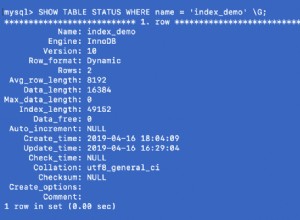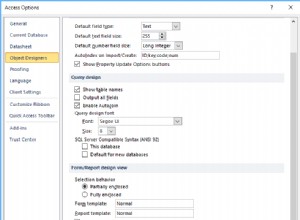Atualizado do SQL 2000 para o SQL 2005 e alterado para o driver JDBC do Microsoft SQL Server 2005 versão 1.2. Recebi o erro "A instrução não retornou um resultado" ao executar um Insert seguido por SELECT SCOPE_IDENTITY().Resolvi o problema usando executeUpdate() e getGeneratedKeys em vez de executeQuery. Aqui está o código antes e depois.
Observação:a conexão usada neste exemplo é java.sql.connection e não com.microsoft.sqlserver.jdbc.SqlServerConnection.
Código SQL 2000
String dbURL = "jdbc:sqlserver" + "://" + dbServer + ":" +
dbServerPort + ";SelectedMethod=cursor;databaseName="
+ dbName + ";user=xxx;password=xxx";
Class.forName("com.microsoft.sqlserver.jdbc.SQLServerDriver");
java.sql.Connection connection = DriverManager.getConnection(dbURL);
sql = "insert into Contact (name) values ('ABC'); SELECT SCOPE_IDENTITY()";
PreparedStatement ps = connection.prepareStatement(sql);
ResultSet rs = ps.executeQuery();
if (rs.next()) {
long id = rs.getLong(1);
System.out.println("Id=" + id);
}
Código SQL 2005
String dbURL = "jdbc:sqlserver" + "://" + dbServer + ":" +
dbServerPort + ";SelectedMethod=cursor;databaseName="
+ dbName + ";user=xxx;password=xxx";
Class.forName("com.microsoft.sqlserver.jdbc.SQLServerDriver");
java.sql.Connection connection = DriverManager.getConnection(dbURL);
sql = "insert into Contact (name) values ('ABC'); SELECT SCOPE_IDENTITY()";
PreparedStatement ps = connection.prepareStatement(sql);
ps.executeUpdate(); // do not use execute() here otherwise you may get the error
// The statement must be executed before
// any results can be obtained on the next
// getGeneratedKeys statement.
ResultSet rs = ps.getGeneratedKeys();
if (rs.next()) {
long id = rs.getLong(1);
System.out.println("Id=" + id);
}




